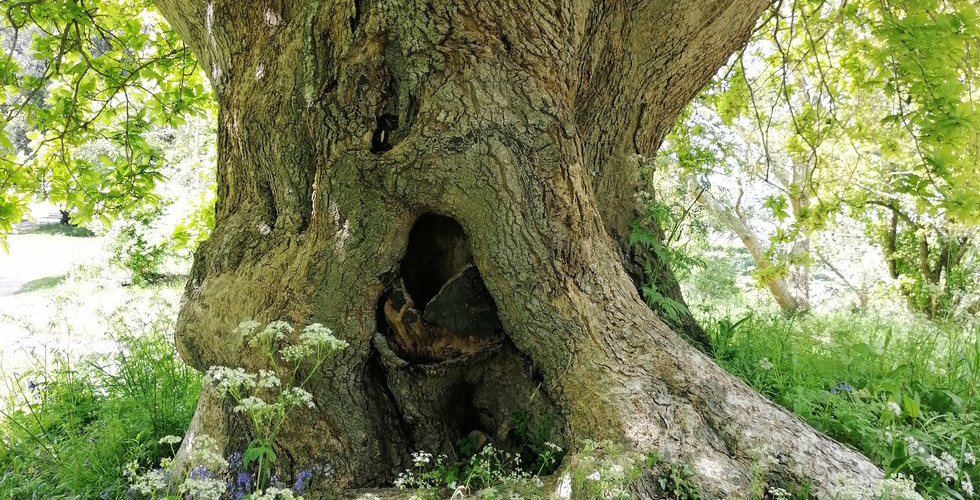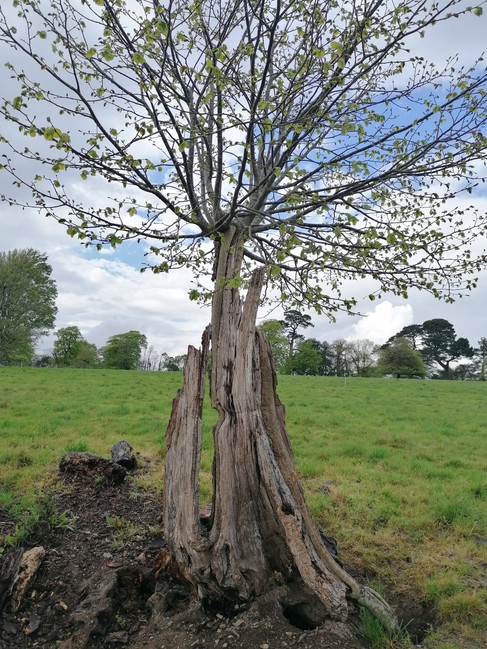In 2021 Land & Heritage working with Devon Wildlife Consultants surveyed veteran trees at 10 National Trust sites on behalf of the Woodland Trust as part of a Green Challenge Recovery Fund project. The aim was to determine their status and future threats/needs.
This post covers various aspects of veteran trees - from the definition to the pressures they face, to give readers a succinct understanding. This collates the recent mini-series Land & Heritage produced on LinkedIn. Here we also reveal some of the findings from the Green Challenge Recovery Fund project. We have included our surveyors favourite trees accompanied by their thoughts.
"I loved seeing this old oak in the Saltram gardens, it reminded me of hunting for fairy trees when I was younger. There was even a hollow I could imagine leading to a mystical land. I think this is part of the beauty of Ancient and Veteran trees, not only do they remind us of the history they have seen, but they can also inspire a wistful imagination often lost when we leave childhood" Megan Dalton
But what is a veteran tree? There is some variation among the arboricultural community but the generally agreed upon definition is that a veteran tree is a tree of any species which is past maturity (in the late stage of its life), or perhaps younger but showing certain characteristics. Often shown by split apical dominance, where growth stops being vertical and also becomes horizontal, with branches even reaching towards the ground. However, it is not simply age which defines a veteran tree unlike an ancient tree, they display several characteristics which mean they are unique in the landscape. Examples of veteran characteristics include large amounts of deadwood in the canopy, presence of fungi and hollowed stems. The three trained and experienced GRCF surveyors recorded 378 veteran trees, including 9 ancient trees across the suite of National Trust sites in Devon.
“Following the contours of a forgotten hilltop trackway, a line of veteran trees hide amongst the woodlands of Buckland Abbey, waiting for those that wander away from the easier footpaths below. They quietly stand guard marking the contours of a path at Buckland Abbey, walked by quiet and hard-working Cistercian monks as a forgotten shortcut centuries before the National Trust was created to safeguard our historic sites. This giant monolith of an ancient male Holly is just one of a series of three brothers in a line, and the phoenix growth that plumes from each main hollow stem ensures he will stand guard for many years to come. Its iron-like heartwood is peppered with beetle exit holes, hollowing him to lighten the load from the strong trade winds on this hillside slope, and hiding this years’ solitary bee grubs amongst a treasure-trove of ecology within.” Nic Harrison-White
Veteran trees hold great ecological importance within a woodland. Due to their unique characteristics such as dead branches and limbs, cavities or hollows in the stem, and epiphytic plants, veteran trees support a whole host of generalist and specialist species. Dead wood on veteran trees supports rare species of fungi, lichen and invertebrates, for example saproxylic insects such as the rare Violet Click Beetle depend on dead wood for part of their life cycle. A recent study has even shown that veteran trees are an important habitat for predatory beetles – natural pest controllers. They were found in higher diversity and density around veteran oak trees compared to young oak trees (Wetherbee, Birkemoe and Sverdrup-Thygeson; 2020).
"I believe these photos really show the resilience of nature. I find phoenix trees amazing in their capability to survive from the remains of what we may have considered a destroyed stump. I think it's an important lesson not to see the natural stresses a tree may endure as always being negative." Megan Dalton
Veteran trees are relics of previous management and in many cases are beloved by the communities which have grown up around them. These trees often inspire names such as the Grandfather Tree or Mother Tree, providing a sense of protection and longevity, linked with life and knowledge in myths and legends worldwide. Unlike Ancient trees, Veteran trees also carry marks and scars to show how much they have experienced in their long lifetime, and more importantly what they have survived. It is very common for veteran trees to be seen as ‘dying’ or ‘unsafe’, followed by a desire to tidy up or remove them. The reality is that a tree becomes more biodiverse as it ages, and as more cavities and wounds create habitats. They are frequently more stable than younger specimens that have raced to maximum height, and will have adapted over time to the stresses and strains of their environment. Veteran and ancient trees are also often older than, or as old as significant buildings within communities, and have as much cultural history associated with them.
“For those that know it well, our south Devon coastline can be a harsh, hostile wilderness with biting winds and needle rain pushing to drive you back from storm watching. But another day it can be an equally soft and inviting landscape, with romantic rolling hills studded with historical gems like this wonderful veteran Lime. For me, this tree sums up both characters in one place. Keepsake for a long-lost stone-faced earth bank and bothy as it hugs a winter storm streambed, I can imagine a sheep herder sheltering a sudden storm under its last few clinging leaves, much as I did the day I found it.” Nic Harrison-White
There are many threats which put our veteran trees at risk. These can be natural threats such as over shading by surrounding trees, bank erosion around trees near water courses or uprooting in a storm. However, there are many modern threats which trees now face in the current epoch – the Anthropocene. For example, tree roots can be greatly impacted by roads and paths, not only can they be damaged if topsoil is removed cutting roots in the process, but layering concrete or tarmac on top of roots prevents water penetration and adds a non-breathable layer of material above the roots. Modern agricultural practices have also increased the pressures on veteran trees, particularly mechanical ploughing within a tree’s root protection zone, which can cause major damage to roots spreading under the surface. Trees are able to redirect roots and survive, however this takes energy and continued damage over a prolonged period of time can lead to the death of a tree.
“This tree is special to me as I felt a sense of privilege in finding such a character; in sharing a vista across the River Dart that few visitors brave to see across the steep slopes of Greenway, but also for timing my visit perfectly to witness a cornucopia of fruiting bodies of special fungi hosted by this giant veteran. Sunshine made the fresh Lime leaves glow like jewels above the gnarly and twisted stem, pocked with epicormic swirls and fissures to mysterious cavities within. These new leaves, unseen by anyone but me as they spread for yet another coming summer, remind us that these trees are links to the past, but are also ours to safeguard into the future.” Nic Harrison-White
Veteran and ancient trees are in decline in the UK, and like much of the natural world the future can feel bleak. It takes hundreds of years for a tree to veteranize, but more than that, it needs a landscape in which to thrive. The narrative is changing however, and land policy seems to be moving in the same direction, encouraging farmers, developers and landowners – all of us in fact – to celebrate and protect our tree populations. On the whole veteran trees need to be left well alone, without invasive tree surgery, and with a protected growing environment. Creating the conditions for future veteran trees to thrive is what we must do, resisting our tidying-up tendencies, identifying special trees, and ensuring that competition or threats are reduced. They in turn will become biodiversity hotspots, enhancing the lives of everyone and everything around them.
Of the 378 recorded veteran trees, 108 were determined to be at risk of life-shortening threats with action required within two years, 2 threatened with action required within one year and 3 critically threatened with immediate action required. We hope this information will allow funding to be correctly distributed between the various National Trust sites in order to preserve our living monuments.
If you want to learn more about schemes supporting woodland creation see our blog on the New Woodland Creation Fund, or our blog on Woodland Management Planning.
Megan Dalton




























